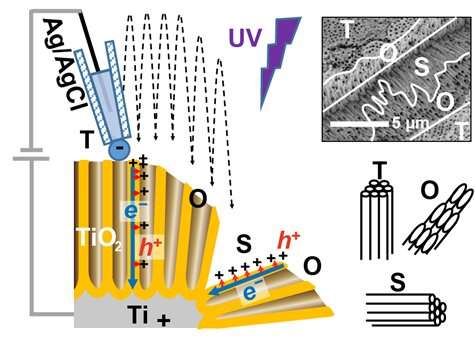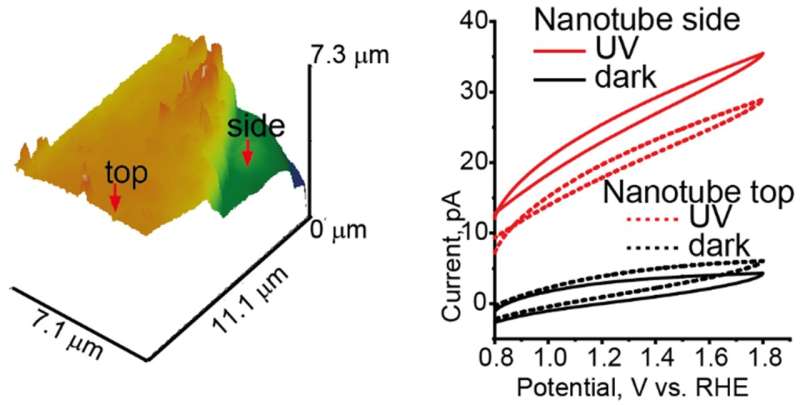Charge separation imaging on the surfaces of titanium dioxide photoelectrocatalytic nanotubes

In a recent study published in the journal ACS Catalysis researchers from Kanazawa University describe novel scanning electrochemical cell microscopy measurements to determine sites of photoelectrochemical activity in titanium dioxide nanotubes.
Semiconducting devices harness the power of light to produce other types of energy: electrical or chemical. One application of this technology is producing hydrogen molecules from water—in a process known as photoelectrochemical (PEC) water splitting—as a renewable source of energy.
Photoelectrolytic cells include semiconductor electrodes, in which hole and electron get spatially separated when irradiated with light with the energy higher than certain threshold. The flow of charge initiates the PEC reactions. Nanotubes of titanium dioxide (TiO2) are semiconductors that are widely used for this purpose. However, the distribution of charge flow on the surface of TiO2 tubes is not clear. Now, Marina Makarova at Kanazawa University and colleagues in Japan and Europe, have used an innovative technique called scanning electrochemical cell microscopy (SECCM) to identify this distribution.
To first measure the success of PEC water splitting, the release of oxygen (the reaction product accompanying hydrogen) was measured. Its production was additionally characterized by lead (II) ions added to the cell, so lead (IV) oxide (PbO2) particles were found deposited on the walls and top of the TiO2 nanotubes suggesting similar electrochemical reactivity at both of these sites. The research team then employed SECCM to clarify the photoreactivity on both sites at different electrode potentials.

SECCM involves the use of a narrow pointed pipette probe to measure electrical changes at specific locations. This probe is filled with a conducting fluid known as an electrolyte which is located between two charged electrodes. One electrode is immersed into the electrolyte, while the second is connected to the sample surface. Measurements were taken perpendicular to and parallel to the length of the tubes to determine differences in reactivity on the walls and the top, respectively. Now, the free electrons typically move along the length of nanotubes towards the positive electrode within the cell. When these electrons delocalize and jump to conducting band, they leave behind "holes" which are nothing but pockets of positive charge that can move about. The SECCM results showed the presence of similar electrical activity along the walls and the top of the nanotubes. Since activity at the top could be preferentially attributed to the movement of electrons, this suggested that holes were instead traversing shorter distances and moved perpendicular to the tube length towards the walls. This flow along a direction orthogonal to the tube length explained why PbO2 depositions were also found on the walls of the tubes.
"This information could be used to establish further correlations between the photocurrent and the microstructure of 1D nanostructures, and for site-specific decoration with co-catalysts or visible-light-responsive sensitizers," say the team. Understanding spatial patterns of electrochemical activity is important to design efficient and cost-effective photovoltaic cells. Furthermore, a combination of oxide deposition and SECCM might be the most sensitive tool in identifying active sites.
More information: Marina V. Makarova et al, Direct Electrochemical Visualization of the Orthogonal Charge Separation in Anatase Nanotube Photoanodes for Water Splitting, ACS Catalysis (2022). DOI: 10.1021/acscatal.1c04910
Journal information: ACS Catalysis
Provided by Kanazawa University





















